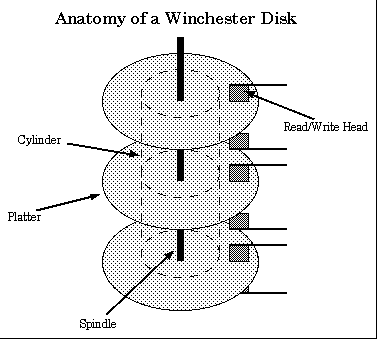![[EdCert previous]](../../../edcert/images/prev.gif)
![[EdCert next]](../../../edcert/images/next.gif)
![[EdCert top]](../../../edcert/images/top.gif)
A Winchester disk consists of a series of rotating platters within a sealed case. The platters are magnetically sensitive and hold the disk data. They rotate at a constant speed; they rotate as long as power is to the machine. Data is read or written to the platters by means of read/write heads, which float a short distance above each platter. The heads never actually touch the surface of the platters (if they accidentally touch, this is called a head crash, and results in serious disk damage).
The head can occupy a discrete set of positions on the disk, called tracks. Tracks are divided into sectors, which are further divided into disk blocks. A cylinder is a set of tracks all of which are the same distance from the central spindle.

For more information on disk hardware is available from another site
The device interfacing system most commonly used on Unix systems is SCSI, for "Small Computer Standard Interface". Although SCSI is generic enough to be used for all kinds of peripherals, it is most commonly used for disks, tape drives, and other media.
The SCSI standard permits for a total of eight devices on the SCSI bus, including the SCSI controller itself. Each device is assigned a unique SCSI ID (or target number) that identifies it. Target numbers go from 0 to 7; ID 7 is usually assigned to the SCSI controller. SCSI IDs are arbitrary and don't determine which device takes priority, although some systems designate certain SCSI IDs for the boot drive, tape drives, CD-ROMs, and so on. The Unix device special file is often (but not always) related to the SCSI ID of the device. The method of setting the SCSI ID of a device varies; some use an external thumbwheel with a numeric display, some use DIP switches, and some require setting jumpers.
The 50-pin Centronics connector is the most common type of connector used in SCSI cabling. Other types of SCSI connectors commonly in use are DB-50, DB-25, and the 50 pin "mini-micro" connector.
Each end of the SCSI chain must be terminated by a set of resistor packs. The controller end is usually terminated on the board. SCSI devices are connected in series. Internal SCSI devices typically use ribbon cables with several plugs attached, one for each device. External devices are daisy-chained together, with each device having one cable coming from the previous device and one cable going to the next. The last device on the chain is the one which is terminated. Terminators may be active or passive; active terminators are usually either labeled as such or have an LED. Some newer SCSI controllers complying to the SCSI-2 specification require the use of active termination; there is no harm in using an active terminator on an older SCSI system.
It is important to be careful with SCSI termination. Some devices have internal termination which is activated by jumper settings or by placing resistor packs in designated sockets. For the sake of simplicity, it is usually best to turn off the internal termination on all of the SCSI devices in use and use external terminators; this makes changing the SCSI configuration much easier.
Recently, Fast SCSI and Wide SCSI have come into more common use. Fast SCSI is a change in the SCSI protocol that allows for a twice as many data transfers per second. Wide SCSI allows for more than one byte of data (up to four) to be handled per transfer. This is accomplished by running multiple SCSI cables per device. Fast SCSI often has problems with electrical noise when used over ordinary SCSI cables, so there are sometimes alternate cabling systems used for Fast SCSI as well. A SCSI device or controller may be wide, fast, or both.